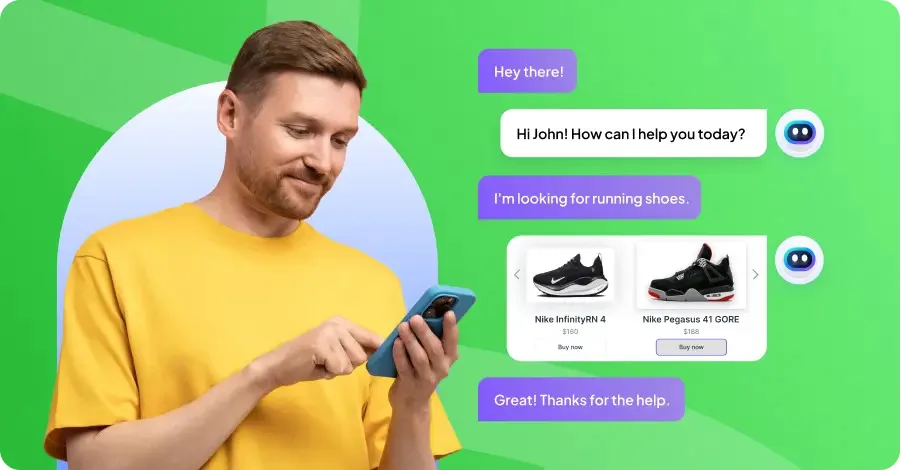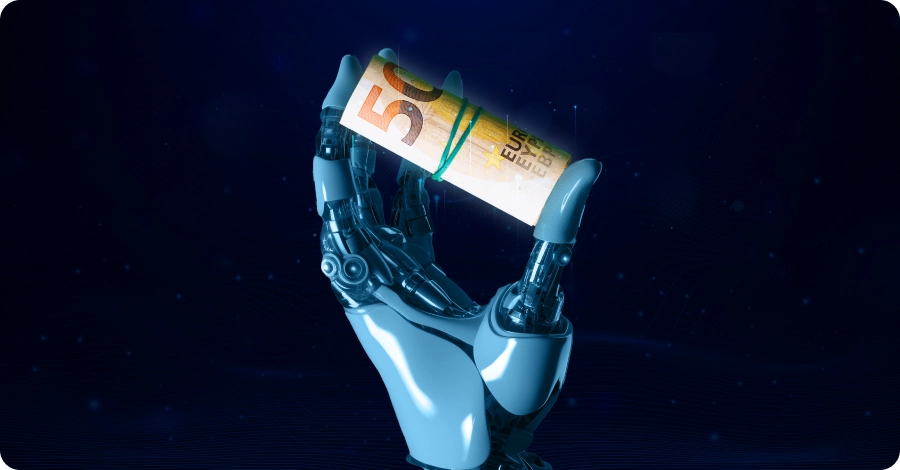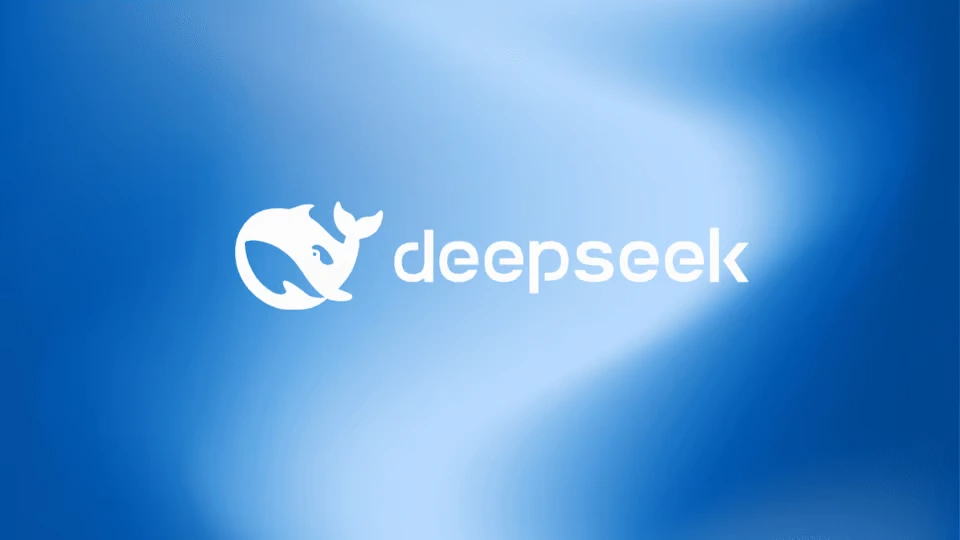Chatbot Intent – Types, Classifications, and Training Steps
- March 7, 2023
- 10 mins read
- Listen

Table of Content
Chatbots have become very popular tools for customer engagement. A growing number of businesses now use these powerful AI-driven software programs to engage with users and provide value across sales, support, or marketing. However, not all chatbots are value-driven and only those with the ability to recognize user intent can communicate effectively with users.
In fact, recognizing user intent is a key aspect of a chatbot’s overall functionality. And if a chatbot is not able to understand the purpose of a user’s message, it may offer irrelevant responses, causing a poor user experience. By contrast, a chatbot that can accurately interpret user intent ensures relevant responses, resulting in a more engaging experience for the user.
So, you should design the chatbot with user intent in mind. It’s also important to consider the different types of intents that users may have so that the bot can handle conversations with ease. All this can never become possible unless your chatbot is equipped with natural language processing (NLP) techniques as only they help recognize and interpret intent in real-time.
In this blog, we will take a closer look at chatbot intents, understand why they are one of the building blocks of an AI chatbot, analyze different types of intents, and also see the steps in developing an intent-based chatbot for your business.
What is Chatbot Intent?
The intent is simply the motive of a chatbot user. It’s the intention behind a message that the chatbot receives. Chatbot intent training can also be defined as the purpose that a user has or a goal that a user wants to achieve out of the interaction with a chatbot.
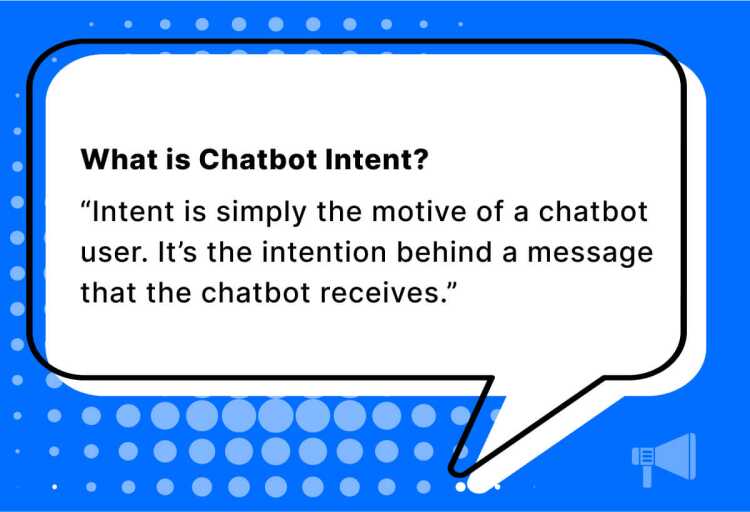
In other words, the intent is the reason why a user is communicating with the chatbot. And the ability to accurately interpret user intent is key to the success of a chatbot. NLP helps the chatbot identify the intent behind each message.
Once the chatbot identifies the intent, it can offer a response that meets the user’s specific query. More importantly, chatbots can be trained to recognize various types of intents, offering personalized responses to users.
Types of Chatbot Intent
Chatbots can be trained to recognize various types of intent that help them provide more effective responses to users. In fact, bots that are able to identify the user’s intent can meet specific needs and ensure a better experience. After all, 74% of users now prefer chatbots when they need answers to simple questions.
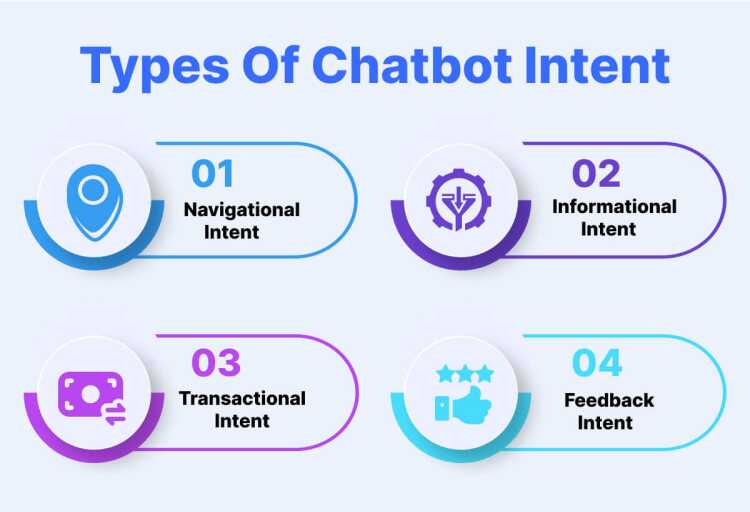
There are various types of intent that a good chatbot can easily recognize.
- Navigational intent – It focuses on helping the user easily navigate a website or app and find the information they look for.
- Informational intent – It focuses on offering information to the user or providing answers to a question or recommending the product.
- Transactional intent – It focuses on helping the user complete a transaction or order a product or service.
- Feedback intent – It focuses on collecting user feedback or asking ratings, reviews, suggestions, or opinions about a product or service.
Apart from these four main types of intent, there could be some other intent as well that entirely relies on the type of conversations a business wants the chatbot to perform. So, intent could also be for solving problems, engaging in casual conversation, or doing social interaction.
What is Chatbot Intent Classification?
Intent classification is the process of identifying the intent behind a user’s query in a chatbot conversation. It’s done using natural language processing (NLP) and machine learning techniques, and the purpose is to use the information to offer a relevant response to the user.
With this process, the user’s message is classified into one of several predefined categories where each one denotes a specific request that the chatbot would handle. The purpose of intent classification is to analyze and then group the messages into “intents” that represent the information the user is looking for.
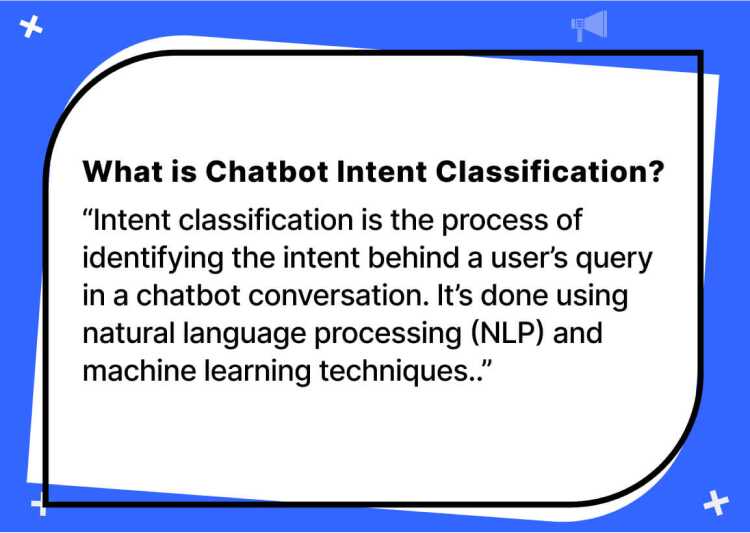
Some benefits of chatbot intent classification include –
- Intent classification is a key aspect of the chatbot development process and it makes the bot capable of offering responses in a natural way.
- By classifying user intent, a chatbot can offer relevant responses to users’ queries, helping businesses boost customer satisfaction.
- Intent classification helps chatbots automate responses to common user requests, therefore increasing efficiency in customer service processes.
- Chatbots that classify intent are able to understand the specific needs of each user and that’s why they can deliver more personalized responses.
- User intent analysis enables chatbots to gather key data about customer behavior and preferences, which can be used to enhance the user experience and improve the bot’s performance.
- Chatbots that classify intent can handle a big volume of requests and queries at any point in time,e which adds an element of scalability to them.
Chatbot Intent Examples
Entities are often very similar across industries as they refer to nouns. However, intents can be both similar as well as different not only across industries but across companies as well. So, the specific intents will depend on the kind of business and customer needs you have.
Here are some examples of chatbot intents –
- Bookings – This kind of intent is common and is used for scenarios where the user wants to book either a flight, hotel, resort, or any other service on a specific date, time, or location.
- Scheduling – This kind of intent example is for cases where a user looks to schedule an appointment, be it with a doctor or for any other purpose.
- Order Tracking – This kind of intent is used to help users track the status of their order.
- Product Information – As the name suggests, this kind of intent is used when a user seeks information about a specific product.
- FAQ – This type of intent example is for scenarios where the user wants answers to those common questions or FAQs about a product or service.
- Customer Support – This type of intent is used when the user wants help from a customer support representative.
- Feedback – This type of intent is used when the user wants to give feedback or complete a survey.
Chatbot Intent Training Steps
Intent training has a big role in helping create a chatbot that is not only effective but friendly to users as well. The purpose of such training is to enable the chatbot to meet the specific needs of your user and deliver relevant responses. However, training a chatbot’s intent is not an easy process and it requires planning, iteration, and continuous improvement over time.
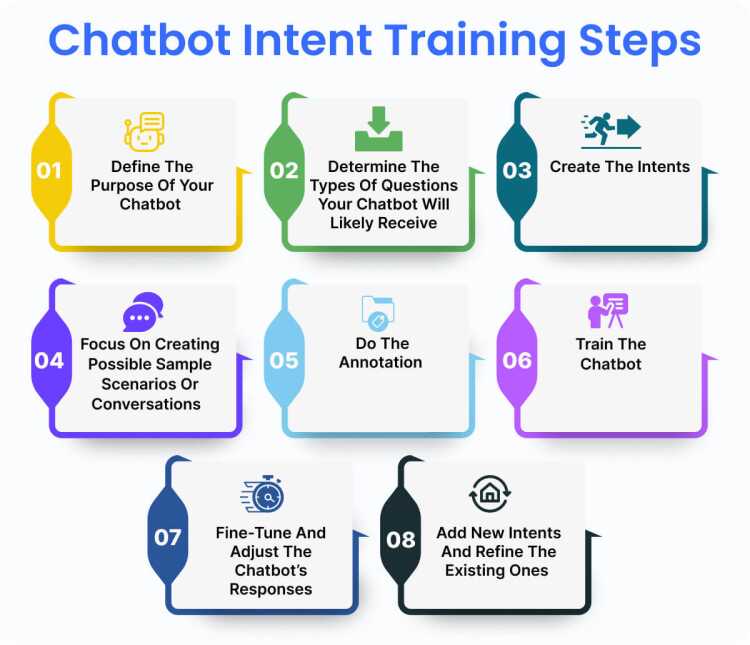
The key steps involved in chatbot intent training are –
Define the purpose of your chatbot
A good chatbot is one that is designed and developed to solve specific problems. So, the first step in intent training starts with defining the goals of your chatbot, i.e., to know the kind of problem the bot would solve. It’s equally important to define whether the chatbot is meant to help customers with a particular task, provide support or answer customer inquiries.
Determine the types of questions your chatbot will likely receive
Once you are sure about the goals your chatbot needs to achieve, the next step is to determine the types of questions it will get. Here, you need to understand what users look for and what types of phrases they might use to meet their needs.
Create the Intents
Now that you have determined the purpose or the goal and the type of questions your chatbot may face, the next step is to create the intents and group them to make a list. When creating the intents, make sure each one is for a specific goal that your chatbot will serve.
Focus on creating possible sample scenarios or conversations
An advanced chatbot is able to understand a user query no matter how many different ways the user asks it. It happens because such chatbots match the questions to the specific intent. That’s why you too should create various strands of possible sample conversations that users might have with your chatbot.
Do the annotation
The next step is very vital as here you will need the data to train the bot’s machine learning algorithms. For that, you will have to annotate the possible conversations for its key constituents. The annotation will find the intent and entities from the texts.
Train the chatbot
Training the chatbot with annotated data is the next step. For the training, you need to use NLP and feed the data into an ML Model. Based on the input, the model will learn to predict user intents, and also recognize patterns.
Fine-tune and adjust the chatbot’s responses
After training the chatbot, the next step is to test it with real user input. You will need to refine the training as per the user feedback. The focus should be on adjusting the bot’s response in correspondence with user interactions.
Add new intents and refine the existing ones
The last step is iteration and improvement, and it’s an ongoing process of chatbot intent training. Here, you need to add new intents and refine the existing ones so that the quality of responses can be enhanced. The goal is to make sure the bot is giving the right outcomes, resulting in a better user experience.
How to Build Intent-Based Chatbot and Boost Customer Engagement?
Building an intent-based chatbot was once a complex task. It needed coding and in-depth technical knowledge. The scenario, however, is changed now, thanks to the arrival of powerful bot builder platforms.
With REVE Chat, you can build your bot with a drag-and-drop method, and that too without writing a line of code.
You can not only create AI-powered chatbots but can also provide intent training and add all the features that a top-class chatbot should have.
More importantly, our platform has a host of other impressive engagement tools your business can use for engaging customers better.
We have video chat and co-browsing software for helping you with visual engagement. These tools can help you serve your customers in a personalized manner.
You can also use our live chat software and provide 24×7 support. All the tools can make your support team more agile and more productive.
Conclusion
The intent is a key component of chatbot development. And chatbots that are able to decode, analyze and interpret intent tend to perform better. That’s why AI chatbots are used across industries for various tasks across sales, support, and marketing.
You can sign up here and start a free trial of REVE Chatbot and check its ability, features, and performance against tasks for your business.
Our platform has tons of amazing engagement tools that can help you redefine customer engagement and boost conversion for your business.
Frequently Asked Questions
Chatbot intent determines the intention behind the user’s query while entity is the parameters used to fulfill the intention.
There are four types of chatbot intent:
- Navigational Intent
- Informational Intent
- Transactional Intent
- Feedback Intent
Yes, AI chatbots have intent as it is important for the bot to understand and interpret human language.
Intent recognition, also known as Intent classification, is a chatbot’s way of organizing and categorizing queries based on user intent.

